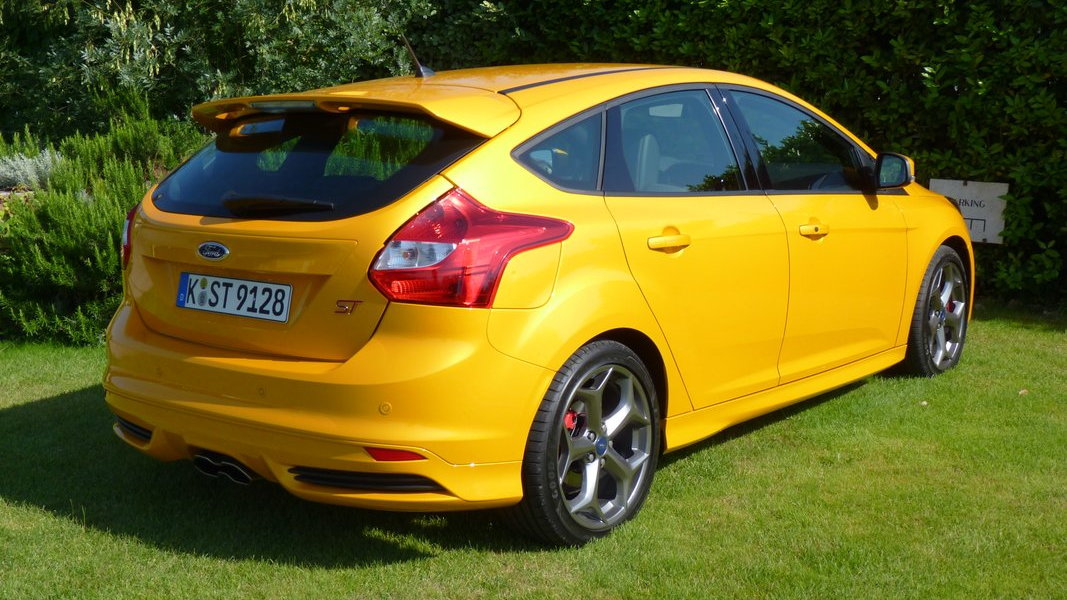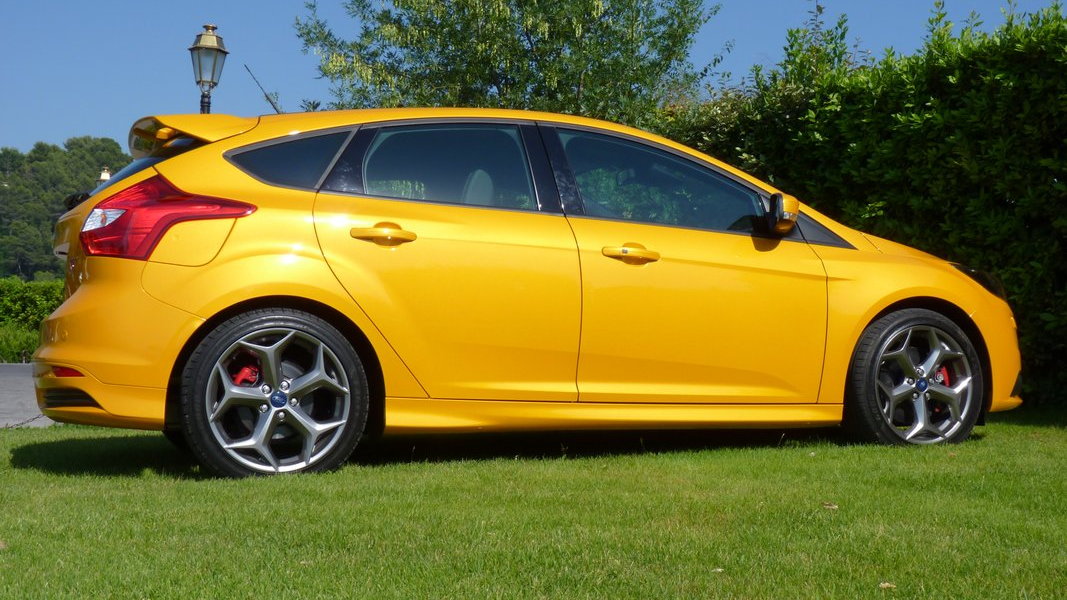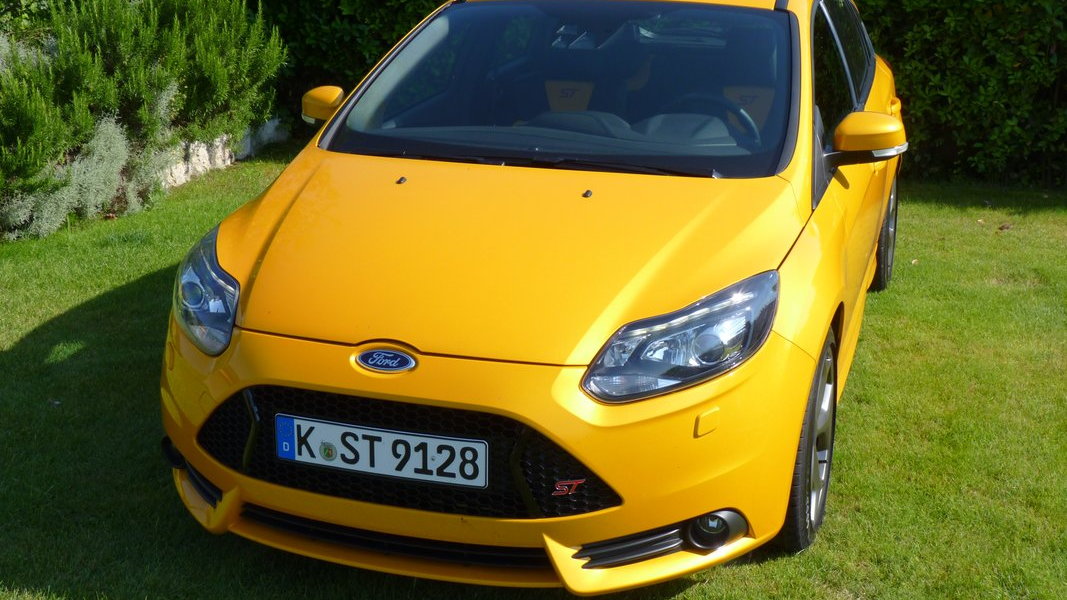If there's a poster car for the 'One Ford' mantra, it might just be the new 2013 Ford Focus ST. Without Ford's initiative to consolidate global development for same-sized vehicles under single development teams—and models that will work in all major markets—it's likely we'd never have seen a high-performance Focus that's this good, this much fun to drive, and with this high-value, under-$25,000 base price.
What's arriving to dealerships in September is a sophisticated, high-performance hatch that doesn't feel like a Focus with some bolted on go-fast equipment; rather, it's refined for a hot hatch, worth the extra money over a well-equipped standard Focus, and a better performance deal compared to some other rivals.
It’s not all that surprising that the 252-horsepower 2013 Ford Focus ST can dash to 60 mph in about 6.3 seconds (conservatively) and reach a top speed of nearly 155 mph. For this much-anticipated model, that’s pretty much exactly the performance package we’ve been primed to expect in this true enthusiast hot hatch.
What is surprising on many levels is the suave execution. This is a vehicle you could drive daily, without annoyance, and without having to budget for a chiropractor. We say this because many of the smaller performance models make some sacrifices in ride and road/engine noise that can be pretty hard to live with daily. As we found in a drive of the Focus ST on a wide range of road types in Southern France this past week, this is one small performance car that you shouldn’t at all be afraid to drive on the commute, or take on the long-distance road trip.
Refined enough for the commute
The new 2.0-liter EcoBoost four-cylinder engine is superb, and we confess to wondering whether it was too quiet and refined at first. It features direct injection but is lacking the clattery sounds at idle that usually call it out; once underway, you'll also note that Ford has masked this turbocharged engine's telltale whistle of forced induction, and the rap of a wastegate (it points to very precise metering instead). Match that with the remarkably instant power delivery in the mid-range revs, and it's sometimes easy to forget that you're driving a significantly boosted (16 psi) turbocharged engine.
Those technologies, combined with Ford's Ti-VCT variable cam timing system allow the engine to make 250 pound-feet of torque, with a remarkably flat, wide torque curve that makes it all available from about 2,000 rpm through to 4,500 rpm. And thanks to a special overboost allowance in the ST, it can go into an 'overboost' mode for up to 20 seconds (depending on conditions), making a peak 270 pound feet at 2,500 rpm.
On small French backroads, passing slow-moving Citroen Picassos and overloaded cargo trucks, the wallop of that overboost mode proved addictive for quick passing bursts. Provided you're in second, third, or fourth gear and at 2,000 rpm or higher, a quick foot to the floor is met with an almost instantaneous rush of acceleration. No need to worry about peakiness or a narrow sweet spot here, either; although less frenzied near the top of its rev range than you'd expect, it builds all the way up to its 6,500-rpm redline.
Unlike a number of other models with more expensive twin-scroll turbochargers, the Focus ST only has a single-scroll unit, but you'd probably never know the difference. The only thing we noticed was that while BMW rations out the power delivery of its new turbo four in the 3-Series with a nice, linear pedal calibration, the Focus ST has a pretty aggressive, all-at-once tip-in that takes a little getting used to—and a little finesse.
Row your own—soundtrack provided
Another way that Ford is saving money with the ST is by offering it only with one transmission—a six-speed manual gearbox that's a little notchy, with throws that we thought were a little too long fore-aft but close and tight side-to-side. Drivability is a big plus, though; the ST’s clutch takeup is about as smooth as it gets in a performance model. Ratios span a wide range, with fifth and sixth quite tall (we saw about 2,600 rpm at 70 mph).
The ST gets a stylish central-outlet exhaust that's visible from afar, but you can't hear the ST all that much from the outside. Raspy, boomy engine notes can get very fatiguing for more than a short drive, so Ford opted for an innovative solution: the so-called Sound Symposer. Essentially, Ford designed a resonating chamber (meant to carry over some character from the raspy five-cylinder of the Euro-only last-generation ST) just below the intake flow; when you press the accelerator to a particular level, in a particular rev range, a flap opens, allowing low-frequency sound from the chamber to be piped back within the instrument panel. During more relaxed driving or cruising, it's quiet and refined—and it can pass tight European exhaust-note regulations—while also inspiring during performance driving.
We've found the base-engine versions of the Focus to offer handling that's sharper and more engaging compared to ordinary compacts but nowhere close to performance-car caliber. To give the ST more of an enthusiast feel—and something special, dynamically—Ford has made some serious changes to its suspension and steering. In addition to a stiffer calibration, and a setup that's lowered 10 mm, Ford upgraded the rear suspension knuckles, and moved the (thicker) rear stabilizer mounting points about three inches out on each side—adding more than six inches of width altogether.
The wider rollbar mounting, along with a completely different variable-ratio steering rack, add up to a sort of one-two punch on tight hairpins. Go smoothly into a wider corner with a lot of speed and the ST will understeer predictably—though you can back off with your right foot and neutralize it momentarily. Pitch it harder into a tighter corner—or intentionally go in a little too hot—and all four wheels will drift to a degree, controllably. And on the tightest corners, the wide rollbar setup makes it feel as if, just at the moment more weight is going to transfer to the back, that wide stabilizer bar spots you, keeping you back on course. All the while, the variable-ratio system keeps the ST feeling stable and confident on straight roads and gradual sweepers, yet allowing you to go into tight corners with bite, as well as through series of esses without losing your hand placement on the wheel.
Confident in back, scrambling in front
But of course when exiting corners you do have to be careful; as a high-powered front-wheel-drive car, the ST has front wheels that scramble madly for traction on full-throttle exits. Electronic systems (Cornering Under Steer Control, Torque Vectoring Control, and electronic stability control) all help smooth out the behavior, but you still need to have both hands firmly on the wheel—and plan on holding tight if the road surface is choppy.
The stability system does come in three different modes: normal, Sport, and a full off setting (for track use). But even in normal mode the system was relatively unobtrusive, we found.
A few of the things you might expect to see on a performance-oriented car in 2012 are simply not here; for instance, there’s only one calibration for the steering and throttle. That said, the steering gets a lower assist level with speed, so most should be happy with it. Otherwise, those in the snow belt should pause and consider all-season tire options. At this point, all STs come with Goodyear Eagle F1 Asymmetric2 tires, and on the drive we noticed a big difference in grip and progressivity between when they were cold and heated up.
One other thing potential buyers should consider carefully is whether they want the deeply bolstered Recaro sport seats or not. We appreciated their firm comfort and good support (no bracing required in the passenger seat). But they'll prove simply too deep and too narrow for many American-size drivers, so if you can, sit in them. The base ST gets essentially the same seat that's in upper-trim U.S. Focus SE models, so wider drivers should stick to that.
The ST will be available in the U.S. in three different trim levels—essentially ST, ST2, and ST3. The base cars start at a bargain $24,495, while the ST2 model costs $26,880 and adds those Recaros plus automatic climate control. At the top of the line, the ST3 adds heated leather Recaros with pull-out thigh support, along with a special Recaro rear bench seat and bi-xenon headlamps, for a total of $28,930. Colors include the ST-specific Tangerine Scream, plus Sprit Blue, Race Red, black, white, and silver.
Made in Michigan, same as Europe
Ford anticipates that it will sell around 9,000 Focus ST models in the U.S. and about another 9,000 in Europe—with other regions of the world, like China and Russia especially, unaccounted for but part of the plan. And this is no intentionally exclusive or limited-production model; the automaker does plan to build as many as the market wants (all U.S. STs will be built in Wayne, Michigan). We'll get essentially the same version as Europe, but with different audio systems and a few cosmetic/feature changes.
Against other small performance cars, the ST is tough competition for what's already on the market. The Golf R has a somewhat peakier engine and costs more than ten grand extra, though it does come with a more extensive feature set, as well as all-wheel drive and a surprisingly tenacious (and stoic) chassis setup. At the other end, there's the Mazdaspeed3, which next to the Focus ST now looks ragged and less refined (its ride is surely busier)—with an interior that's definitely not up to the same standards. Of course in the same price range you now also have the Scion FR-S and Subaru BRZ—compelling rear-wheel-drive sports cars, but not nearly as practical.
So for the first time since the SVT Focus of a decade ago, Ford has a serious hot hatch. And if performance for the dollar—in a roomy hatchback—is a priority, the ST is a serious steal.






